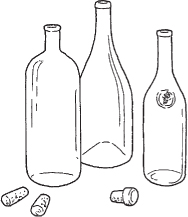
I REMEMBER, YEARS AGO, the first time I visited Harrod’s food hall in London. It was, and remains today, the granddaddy of all food halls in the world. The aisles overflowed with pyramids made of tins of dry mustard and other foods. Overhead displays were laden with sassy bunches of dried herbs tied with ribbon and raffia bows. And a mosaic mural of dried cloves, allspice, dried beans, and other spices adorned the walls. It was an art gallery of food!
In the midst of all this, I found culinary magic in bright, crystal-clear bottles of vinegar, which had suspended inside fruit larger than the bottleneck. I pondered this for years, wondering how they had gotten the fruit into the bottle. Later, I learned that they had threaded the bottleneck over a small, immature, growing peach. They had chosen fruit from a bottom branch, somewhat shaded from the sun, easy enough to reach. Then they removed all the leaves from the branch and tied the bottle over the immature fruit.
After learning how those fruited vinegars at Harrod’s had been created, my husband and I tried this process. We tied our bottles over peach and apple branches and checked them often as the fruit grew. Of course, you don’t want to do this with fruit trees that have been sprayed. It took us many bottles tied to many branches to actually get one completed peach inside. At that stage, all we had to do was shake the branch and the fruit fell off, caught in the bottle. We then followed a recipe for fruit vinegar and ended up with a real conversation piece. In fact, we almost had more fun talking about it than we did eating it.
Looking back, we had many failures but great fun. It’s no wonder the fruited vinegar in Harrod’s was so expensive. But you can make your own flavored vinegar using much simpler methods and ingredients. Give it a try. Flavored vinegars make a meal interesting by providing a little of the unexpected to an otherwise ordinary dinner. Look upon these condiments and seasonings as your helpmates in making good food delicious.
Is it a medicine, cosmetic, preservative, flavor enhancer, cleanser, disinfectant, beverage, or digestive aid? While modern science has had to prove vinegar’s antibacterial and antiseptic powers, inhabitants of the ancient Mediterranean already knew of its qualities. In the Old Testament, reference is made to the medicinal qualities of wine and vinegar. The many flavored, refined vinegars of today are used mostly to enhance and enliven cuisines around the world.
Vinegar, which contains acetic acid, is the natural outcome of fermented fruit juices and grains. Oxygen and the alcohol of wine combine with organisms known as acetobacters to produce vinegar. Each grain or fruit used imparts its own special flavor to the vinegar. The flavor range seems endless. Appreciating the subtle and not-so-subtle vinegar flavors is a full-time occupation. Age, flavoring, and the acidity contribute to the taste and character of vinegars.
Modern vinegar production has been speeded greatly by mechanization — though aged balsamic vinegars are still being produced today, as they were in ancient Italy.
Vinegar is the single most effective vehicle for low-caloric flavoring of meats and vegetables. Sometimes vinegar is identified as containing a certain “grain,” which specifies the proportion of acetic acid to water. A 40-grain vinegar means that it is 40 percent acetic acid. Read the label carefully to determine acidity when you purchase vinegar. For cooking purposes, 4 to 6 percent acidity is ideal. Once you have learned about the differences in flavors, aged versus nonaged, and variations in acidity, you will want to choose the full-bodied, aged vinegars over the pale grocery store varieties every time. Distilled white vinegar is perfect for pickling, but not for making flavored concoctions to enhance your menu.
While homemade vinegar is great for flavoring your meals, do not use homemade vinegar in canning. Usually the acidity of homemade vinegar is much lower than that of commercial varieties, and measuring the exact acidity percentage of your homemade brew is difficult to do. Another problem with using homemade vinegar in canning is that it often contains the “mother” of vinegar, a jellylike, cloudy substance that contains the bacteria used for making vinegar. You don’t want the mother clouding your pickles.
Store flavored vinegars in decorative glass bottles or cruets.
Wine vinegar contains no alcohol, which is oxidized in the process of turning wine into vinegar. All the vinegars listed here are suitable in flavor and acidity for our purposes, but always read labels carefully to check acidity before buying.
Is it a kitchen decoration, gift-giving idea, culinary essential, or the perfect suspension medium for those summer herbs that grow in such abundance? Flavored vinegar does it all. In addition to herbs and spices, you can flavor vinegar with fruits, flowers, and vegetables singularly or in combination.
For today’s cook, it is easy to buy a good-quality vinegar and use your energy and ideas for creative flavor combinations. Remember, poor-quality vinegar cannot be elevated by adding a few herbs to it — always choose the best in the beginning.
The process of bottling flavored vinegars is simple compared to that of canning fruits or vegetables. Because of its high acidity, vinegar prevents the growth of bacteria, eliminating the need for processing with heat. Nevertheless, all the usual rules of cleanliness apply.
Make sure you are prepared and organized before you begin bottling. Use hot, soapy water to wash the bottles and utensils, removing all the soap with hot water. Drain all the washed equipment on clean tea towels. Pour boiling water into the clean bottles and let stand for 10 minutes. The individual recipe will give instructions for steeping or otherwise combining ingredients.
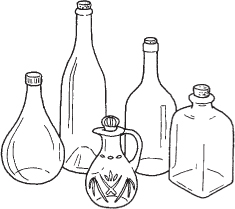
After the steeping process, filter the vinegar into clean, narrow-necked bottles for final bottling.
I find it most convenient to steep the vinegar ingredients in a clean, widemouthed jar. Many recipes call for removing the spices and herbs before the final bottling, and this kind of jar allows you to do that easily. If you steep the ingredients in a narrow-necked bottle, it may be difficult to remove the spices and herbs later. Spices and herbs that remain in the vinegar after bottling continue to impart their flavors. Sometimes this is desirable, as with Lemon-Thyme Vinegar (page 296). Sample your wares after a few days of steeping and decide for yourself. It is a matter of taste. You may choose to leave the seasonings intact. Sometimes the suspended seasonings are quite beautiful and add to the effect of your creation. Often it is a judgment call by the cook. Herbs such as garlic, when left in the vinegar, could eventually overpower the other flavors. So after the herbs and spices have steeped in the vinegar, filter the vinegar through a coffee filter into clean, narrow-necked bottles for final bottling.
Most of the equipment you need for flavoring vinegar can be found in your kitchen (see box at right). The bottles for steeping and storing the vinegar are possibly the only things you will have to search for. Keep your eyes open throughout the year for interesting reusable bottles and jars. Rosé and white wine bottles are best, as they are clear. Pick up a package of generic corks in different sizes the next time you see them at the hardware store and have them on hand for “bottling season.” Of course, you can always buy ornamental glass bottles as well. The upscale home-furnishings stores carry quite an array of them.
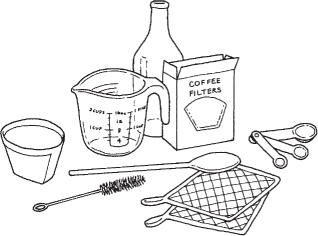
The basic equipment for making flavored vinegars can be found in your kitchen.
Always store your finished product in a cool, dark place. Some light, but certainly not direct light, is okay while the solution is steeping. It is tempting to store vinegars in plain view of guests because the fancy varieties can be quite attractive, but unless you keep your living room dark and cool, don’t do it. Fancy flavored vinegar will keep for 6 months, fruit vinegar for 3 months.
Herbal vinegars are delightfully attractive, wonderfully flavorful, and extremely easy to make. Experiment with different herbs and vinegars to create a diversity of flavors for use in cooking and salads. All vinegars can be paired with herbs, but red wine vinegar and white wine vinegar are the most versatile. More delicate varieties, such as champagne vinegar, are best suited for lemony herbs. Apple cider vinegar and malt vinegar pair well with oniony herbs, such as chives and garlic.
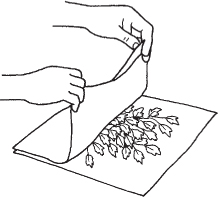
Clean the herbs and then blot them dry on clean towels.
1. Gather the herbs before the midmorning sun hits the leaves but after the dew has evaporated. Clean off all the grit and blot the herbs dry with clean towels or paper towels.
2. Remove the leaves from the stems and measure 1 cup of leaves to 2 cups of vinegar. If you are using dried herbs, choose one-half the amount, or ½ cup of herbs to 2 cups of vinegar. It may seem to be too strong a ratio of herbs to vinegar, but don’t be put off. The solution must be strong enough to be effective even after steeping and straining.
3. Put the leaves into a clean jar and fill with vinegar. Cover the jar and store it in a dark, cool place. Shake or stir the solution every few days and taste it after about 1 week. If the flavor is intense enough and to your liking, it is ready.
4. Strain the vinegar infusion into a clean bottle using cheesecloth, muslin, a clean jelly bag, or a coffee filter. Cork or cap, label, and store in a dark, cool place.
While heat is not recommended for other kinds of flavored vinegars, it enhances the flavor of spiced vinegar by releasing the essential oils in the spices. All types of vinegar work well with spices. Experiment to find your favorite combinations by trying allspice, cardamom, cinnamon, ginger, juniper, nutmeg, peppercorns, and peppers. Use the seeds of herbs, such as anise, caraway, celery, coriander, cumin, dill, and mustard.
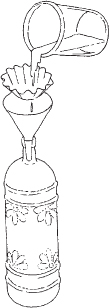
Use a cheesecloth or coffee filter to strain the vinegar infusion.
1. Use whole spices, not the ground form, which could cloud the finished product. You may wish to bruise them slightly or crush them, using a mortar and pestle or a food processor.
2. Heat 2 cups of vinegar to 110°F, being careful not to let it overheat. Remove the pan from the heat and let it cool slightly.
3. Put up to 4 tablespoons of the bruised spices in a clean widemouthed jar along with the 2 cups of vinegar. Cover the jar and store it in a dark, cool place. Shake or stir the solution every few days and taste it after about 1 week. If the flavor is intense enough and to your liking, it is ready.
4. Strain the vinegar infusion into a clean bottle using cheesecloth, muslin, a clean jelly bag, or a coffee filter. Cork or cap, label, and store in a dark, cool place.
TIP
For a sparkling vinegar concoction to give as a gift, include your favorite oil and vinegar salad dressing recipe on a card tied to the bottleneck.
The hardest part of making fruit-flavored vinegar is deciding which fruit to use. The possibilities are nearly endless. Most fruit vinegars fare well with milder red or white wine vinegar as a base to match the delicacy of the fruit flavors. Make sure the vinegar has at least 5 percent acidity.
1. Wash and blot the fruit dry; pit it, if necessary; and peel, if desired.
2. Mash slightly or cut up the fruit and place the prepared fruit in a clean jar with the vinegar. Don’t heat the vinegar for flavoring with fruit; it’s too hard on the fruit, as a rule. The 2-to-1 ratio of vinegar to fruit is good here. Cover with vinegar and place in a cool, dark place to let the flavors marry.
3. After a few days to a week, taste the solution. At this point, you can strain out the fruit and add newly prepared fruit for a more intense flavor. Let the mixture steep for another week or two. Repeat the steeping process until the taste is to your liking.
4. Strain the mixture into a nonreactive saucepan. For each 2 cups of flavored vinegar, add ⅛ cup to ½ cup of sugar, or use 1½ tablespoons to ⅓ cup of honey. Simmer but do not boil the mixture, stirring as the sweetener dissolves, for about 3 minutes. If foam develops, skim it off.
5. Let the vinegar cool and pour it into a clean bottle. Add a fruit slice to the bottle for beauty. Cork or cap, label, and store in a cool, dark place.
The main thing to remember when making floral vinegar is to use nonpoisonous flowers and only those that have not been sprayed with dangerous chemicals. Never use florist flowers. Know your sources or use your own flowers.
Using herbs that have “bolted” in the hot sun of late summer is a great way to flavor vinegars, because the flowers add delicate flavor. If you’re flavoring with roses, though, use only the petals, never the whole rose, and use the inner petals, not the sepal or outer green petals. No matter what kind of flower you use, make sure the petals are clean, dry, and free of insects.
TIP
Use your own pesticide-free flowers for cooking.
1. Choose a mild white vinegar such as champagne, white rice, or white wine. Use 1 cup of petals to 2 cups of vinegar. With some flowers, such as violets, this could end up requiring a very large supply of plant material. Combine the ingredients in a clean, widemouthed jar, then cap and store in a cool, dark place.
2. As with other flavored vinegars, steep for about a week and then taste. Continue to steep a few more weeks if you want a stronger flavor.
3. Strain the vinegar into a clean, small-necked bottle; add a fresh flower, if desired; cork or cap, seal, and label.
How easy it is to turn all your everyday dishes into something spectacular with herb blends and seasonings. Keep on hand your own mix of herbs, spices, and other seasonings. What a luxury to enliven your fresh, steaming-hot produce with a vegetable seasoning right before serving, or to add sparkle to that pot of soup with a spoonful of soup-seasoning blend. Most of these recipes add no calories to your dishes, and they are easy to combine and keep on hand.
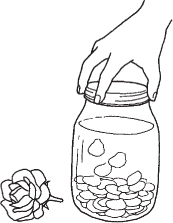
Steep the petals in a mild vinegar in a sealed container.
This hearty vinegar stands up well to grilled pork and beef when used as a marinade ingredient.
1 teaspoon whole black peppercorns
1 teaspoon whole cloves
1 small whole red chile
1 1-inch-piece dried ginger root
2 cups sherry vinegar
1. Combine all the ingredients except the vinegar in a large widemouthed jar.
2. Heat the vinegar just to boiling in a non-reactive 2-quart saucepan over medium heat.
3. Pour the vinegar into the spice-filled jar and let steep until cool.
4. Tightly cover the jar and store in a cool, dark place.
5. Check the flavor after 1 week. Decant from the widemouthed jar through a coffee filter into a narrow-necked bottle. Cork or cap and store in a cool, dark place.
YIELD: 1 PINT
This herb vinegar has a wonderfully light, fresh flavor imparted by a bit of orange peel. Use as is over fresh raw summer vegetables, or add a dash of olive oil.
1 pint red wine vinegar
1 strip orange zest, 1 inch by 4 inches
1 sprig fresh rosemary
1 sprig fresh thyme
1 bay leaf
1 large garlic clove, peeled
1. Combine all the ingredients in a clean 2-cup jar.
2. Seal the jar and store at room temperature in a dark place for about 1 month before using.
3. Filter into a clean 1-pint bottle.
4. Store at room temperature, tightly sealed, for up to 6 months.
YIELD: 1 PINT
Serve this lovely vinegar drizzled over sliced fresh tomatoes or cucumbers.
1 quart red wine vinegar
4 sprigs fresh oregano
3 large stems fresh basil
2 sprigs parsley
2 sprigs fresh rosemary
2 teaspoons whole black peppercorns
1 clove garlic, peeled
1. Combine all the ingredients in a large widemouthed jar.
2. Tightly cover the jar and store in a cool, dark place. Check the flavor after 1 week.
3. Decant from the widemouthed jar through a coffee filter into a narrow-necked bottle.
4. Cork or cap; store in a cool, dark place.
YIELD: 2 PINTS
This recipe makes a large quantity, so plan to give some as gifts.
6 quarts cider vinegar
2 cups sugar
6 tablespoons whole black peppercorns
¼ cup fresh ginger root, peeled and sliced
¼ cup whole allspice
¼ cup whole cloves
¼ cup yellow mustard seeds
3 tablespoons celery seeds
3 tablespoons turmeric
2 tablespoons mace
1. Combine all the ingredients in a nonreactive 10-quart saucepan.
2. Heat slowly, stirring until all the sugar has dissolved.
3. Pour into two 1-gallon jars, dividing the spices evenly. Cover and let steep for about 3 weeks in a cool, dark place.
4. Strain through a coffee filter into six sterile quart jars. Cap, seal, and store in a cool, dark place.
YIELD: 6 QUARTS
This vinegar is a wonderful ingredient in stir-fry sauces.
1 cup fresh ginger root, peeled and sliced
1 tablespoon whole black peppercorns
1 ½ cups rice wine vinegar, heated to 110°F
1. Place the ginger and peppercorns in the steeping container. Press them with the back of a spoon to release the flavor.
2. Add the vinegar. Screw on the lid tightly and store in a cool, dark place. Stir the mixture or shake the jar every other day.
3. Check the flavor after 1 week. Let steep longer, if desired. When the ginger flavor is to your liking, strain the vinegar and use. It will keep for 3–6 months.
YIELD: 1½ CUPS
Marinate fresh tomatoes in this vinegar concoction.
1½ cups fresh mint leaves
6 cups white wine vinegar
½ cup honey, or 1 cup sugar
Zest of 3 lemons
3 fresh mint leaves
1. In a half-gallon container, bruise the mint leaves with the back of a spoon.
2. Add the remaining ingredients and stir.
3. Store in two 1-quart jars, capped and sealed, at room temperature for about 2 weeks.
4. Filter into three clean containers and add a fresh mint sprig for beauty. Store tightly sealed in a cool, dark place for up to 6 months.
YIELD: 6 CUPS
A base for almost any sauce or dressing, tarragon vinegar is a tried-and-true favorite. Combine 1 part vinegar with 3 parts olive oil for a delicious salad dressing.
20 sprigs fresh tarragon
4 cups white wine vinegar
1. In a widemouthed 1-quart jar, bruise the tarragon, using the back of a spoon.
2. Pour the vinegar over the herbs and seal the jar.
3. Store in a dark place for 2–4 weeks, or until the flavor has reached the desired intensity.
4. Remove the herbs by straining the vinegar (or use a coffee filter) into a 1-quart decorative bottle. Cork or cap and make sure the bottle has an airtight seal.
YIELD: 1 QUART
Sprinkle this over fresh sliced tomatoes and cucumbers.
4 sprigs fresh basil
1 clove garlic, peeled
1 teaspoon whole black peppercorns
1 pint balsamic vinegar
1. Combine all the ingredients except the vinegar in a large widemouthed jar.
2. Pour the vinegar into the jar and cover tightly.
3. Store the jar in a cool, dark place. Check the flavor after 1 week.
4. Decant from the widemouthed jar through a coffee filter into a narrow-necked bottle.
5. Cork or cap, label, and store in a cool, dark place.
YIELD: 1 PINT
Try this vinegar with fish or boiled potatoes.
6 sprigs fresh dill
2 fresh dill heads, or ½ teaspoon dill seeds
1 tablespoon yellow mustard seeds
1 clove garlic, peeled
1 quart white wine vinegar
1. Combine all the ingredients except the vinegar in a large widemouthed jar.
2. Heat the vinegar to 110°F.
3. Pour the vinegar into the jar and let the herbs steep until cool. Tightly cover the jar and store in a cool, dark place. Check the flavor after 1 week.
4. Decant the vinegar from the widemouthed jar through a coffee filter into a narrow-necked bottle.
5. Cork or cap, label, and store in a cool, dark place.
YIELD: 2 PINTS
This large quantity is perfect to make when the garden is rampant, then give away as welcome gifts.
1 dozen shallots, peeled
8 sprigs fresh rosemary
8 sprigs fresh thyme
¾ cup fresh tarragon leaves
½ cup fresh parsley leaves
¼ cup chopped fresh chives
2 dozen black peppercorns
3 gallons cider vinegar
3 cloves garlic
1. Combine the herbs and divide the mixture into three 1-gallon jars.
2. Pour vinegar into each jar. Add 1 clove of garlic to each jar and let steep for 24 hours.
3. Remove the garlic. Seal the jar and place in a cool, dry place for 2 weeks.
4. Strain or pour through a coffee filter into twelve 1-quart bottles. Cap, seal, and label. Store in a dark, cool place.
YIELD: 12 QUARTS
Try to peel the lemon in one continuous spiral. “Thread” it into the bottle in a spiral fashion. Beautiful!
2 cups white wine vinegar
1 lemon, peeled in one spiral
2 sprigs fresh thyme
2 teaspoons white peppercorns
8–10 fresh cranberries (optional)
1. Combine all the ingredients in a sterile decorative bottle.
2. Seal and store for 1 month in a cool, dark place before use.
YIELD: 1 PINT
Note: I like to thread about 8–10± fresh cranberries on a wooden skewer and insert the skewer through the neck of the bottle. It’s challenging and fun to try to get the skewer in the center of the lemon spiral. Like building a ship in a bottle, your friends will wonder how you did it!
This is remarkable on fresh fruit.
1 tablespoon coriander seeds
Zest of 1 lime
1 clove garlic, peeled
1 quart white wine vinegar
1. Combine the coriander, zest, and garlic in a large widemouthed jar.
2. Heat the vinegar to 110°F.
3. Pour the vinegar into the jar; let cool.
4. Tightly cover and store in a cool, dark place. Check the flavor after 1 week.
5. Decant from the widemouthed jar through a coffee filter into a narrow-necked bottle. Cork or cap, label, and store in a cool, dark place.
YIELD: 2 PINTS
Use this vinegar as a dressing base for cole slaw. Add two chopped apples to your favorite slaw recipe. Different and delicious!
1½ cups fresh cranberries, rinsed and picked over
1¼ cups white rice vinegar
3 tablespoons honey
1. Heat the ingredients in the top of a double boiler over simmering water for 10 minutes.
2. Cool and store in a clean pint jar for 3 weeks in a cool place.
3. Strain the vinegar through a coffee filter, pressing out all the fruit juices.
4. Funnel into a clean 1-pint bottle.
YIELD: 1 PINT
Use this vinegar in slaw, as a base for pork marinade, or heated slightly with olive oil for a different salad dressing.
2 pints strawberries, rinsed, stemmed, and halved, ¼ cup reserved
1 quart cider vinegar
1 cup sugar
1. In a large 4-quart nonreactive saucepan, combine the berries and vinegar. Let stand for 1 hour.
2. Add the sugar to the saucepan and heat to a slow boil to dissolve the sugar. Simmer for 10 minutes.
3. Use a coffee filter to strain into three sterile 1-pint bottles. Press out as much juice from the berries as possible.
4. Add some of the reserved strawberries to each bottle. Cap, seal, and label. Store in a cool, dark place for 2 weeks before use.
YIELD: 3 PINTS
This is my version of the famous French herb blend. But if you are feeling patriotic, rename it for your local area! This is especially excellent for grilling meats. Sprinkle on lamb chops, chicken, or beef while they cook on the grill.
½ cup dried rosemary
½ cup dried thyme
¼ cup dried marjoram
¼ cup dried oregano
¼ cup dried savory
2 tablespoons dried fennel seeds
2 tablespoons dried lavender leaves
1. Combine all the ingredients and store in an airtight container in a cool, dark place.
2. This will stay fresh for 2 months.
YIELD: 2 CUPS
TIP
Save your grocery store spice jars with shaker-style lids. They are convenient dispensers for many of these blends.
Sprinkle about ½ teaspoon of this spicy seasoning on each cup of buttered popped corn, adjusting to taste. The butter helps it stick to the popcorn, but if you wish to eliminate the fat, sprinkle the blend on hot unbuttered popcorn and stir often to keep it mixed together.
¼ cup ground cumin
3 tablespoons dried oregano
1 tablespoon cayenne pepper (or less to taste)
1. Combine the ingredients and pour into a salt shaker. Sprinkle over hot buttered popcorn to taste.
2. This will keep for 6 weeks in a cool, dark place. Keep tightly sealed.
YIELD: ½ CUP
Dried herbs keep this recipe uncomplicated. This blend is terrific with fish or as a seasoning for fresh tomatoes and cucumbers. Try it on baked potatoes or in soups for a change of pace.
¼ cup dried dill weed
2 tablespoons dried lemon-balm leaves
1 tablespoon garlic powder
1. Combine all the ingredients and store in an airtight jar away from heat and light.
2. Sprinkle on foods according to taste.
YIELD: ½ CUP
This mix of favorite dried summer herbs is good for seasoning fresh vegetables, and when you sprinkle a little on pasta, it becomes a special-occasion meal.
8 tablespoons dried parsley
4 tablespoons dried chives
1 teaspoon dried basil
1 teaspoon dried oregano
1 teaspoon dried sage
1 teaspoon dried thyme
1 teaspoon garlic powder
½ teaspoon celery seeds
1. Combine all the ingredients and store in an airtight container away from heat and light. The garlic can sink to the bottom of the container, so stir well before each use.
2. Sprinkle on vegetables, buttered pasta, salads, or soups, as desired.
YIELD: ¾ CUP
Dried red pepper flakes give this spice mix an extra kick. Use this blend anytime you want a southwestern flavor for cream cheese dip, chicken salad, tangy soup, or chili. Good with any recipe calling for chili powder.
3 tablespoons chili powder
2 tablespoons ground cumin
1 tablespoon freshly ground black pepper
1 tablespoon garlic powder
1 tablespoon salt
1½ teaspoons dried red pepper flakes
1. Mix all the ingredients thoroughly in a small bowl.
2. Store in an airtight container in a cool, dry place for up to 3 months.
YIELD: 8½ TABLESPOONS
This combination gives rice a hot, complex, wonderfully seasoned Thai flavor. Use it for stir-fried vegetables as well.
4 tablespoons dried mint leaves
2 tablespoons dried lemon zest
1 tablespoon ground white pepper
2 teaspoons dried lemon verbena leaves
½ teaspoon cayenne pepper
¼ teaspoon ground cumin
1. Combine all the ingredients in a blender and pulverize to a fine powder.
2. Store in an airtight container away from heat and light. Add to rice or stir-fried vegetables according to taste.
YIELD: ABOUT ½ CUP
Herbs and spices give vegetables and other foods a new dimension. Start with ½ cup (1 stick) of softened butter, and then add one of the combinations below. Seasoned butters will keep for several days in the refrigerator.
1 teaspoon dried rosemary, crushed
1 teaspoon dried thyme, crushed
¼ teaspoon ground white pepper
2 teaspoons dried basil, crushed
¼ teaspoon freshly ground black pepper
¼ teaspoon onion powder
¼ onion, finely minced
½ teaspoon ground cumin
½ teaspoon dried oregano, crushed
¼ teaspoon cayenne pepper
2 teaspoons dried oregano, crushed
2 cloves garlic, peeled and minced
¼ teaspoon freshly ground black pepper
YIELD: ½ CUP (EIGHT 1-TABLESPOON SERVINGS)
NUTRITION PER SERVING
